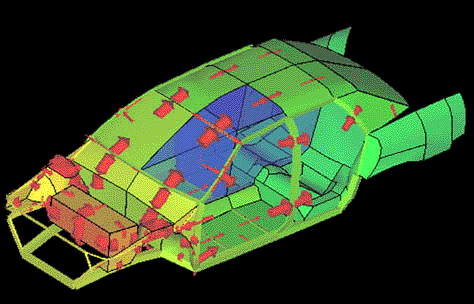|
Modern scientific modeling software can visualize the dynamics of solid (3D) forms. The approach is a physics-based one where the interaction between discrete regions of the material, elements, are measured. The technique is known as Finite Element (FE) Analysis, and can be discretized to the level of atoms. Beyond this range (subatomic, liquid, gaseous, condensed matter) the approach for modeling is a somewhat similar technique know as Computational Fluid Dynamics (CFD), which deals with discrete regions, but approaches them through different equations. More generally FE is used at a larger scale; machine components, structural analysis, and other engineering concerns. Car impact simulations use a FE approach in place of many crash-tests. Aeronautical engineering, particularly aerospace where intense stresses are present, use FE in combination with CFD to determine stresses (essentially noise vibration) that impact a structure, such as a wing. |

|
| A popular software package for doing this is ANSYS. ANSYS is a collection of a broad array of equations, a subset of which can be used to approach acoustic modeling. Most obviously, speaker design is one of the primary markets for this. It can also be used in more engineering-specific needs, such as the aerospace or automotive industry, where noise vibration will lead to part wear - costs for the warranty holder on the short term, or the car owner on the long term. Acoustic FE is often referred to as Boundary Element Analysis (BEA). A few companies have begun to curtail these techniques toward modeling and visualizing sound radiating from an object. | |